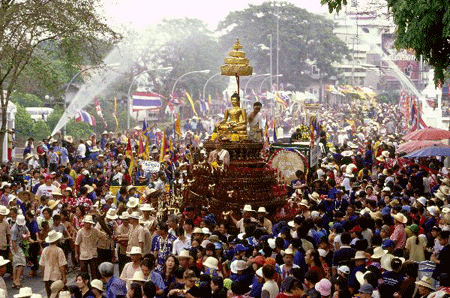
Prepare to get soaked with the crowds on Khao San Road and elsewhere in the city at the traditional Buddhist New Year festival of Songkran. The watery celebrations go on all night and through much of the next day.
It starts gently enough. A few sprinkles and a dusting on the cheeks with fragrant sandlewood paste greet arrivals to Khao San Road. But by noon on the first day, buckets of water are flying, double-barrelled water pistols are aimed and even water trucks serve as formidable reinforcements, blocking off the end of the street. Market stall-holders stay away and even a tactical retreat to one of the many restaurants or bars is no reprieve – just hold your drink away as the buckets are poured over you…
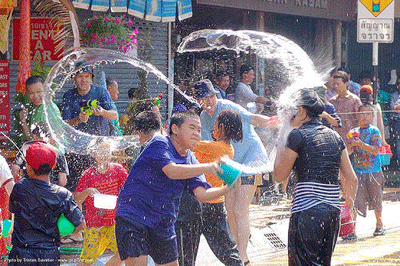
Though it might sound like warfare, Songkran in Khao San Road is a lot of fun. It’s no coincidence that the festival occurs at the hottest time of the year, so no one minds getting soaked.
In Sanam Luang park, for example, close to Khao San Road, the Phra Buddha Sihing image is displayed and devotedly bathed.
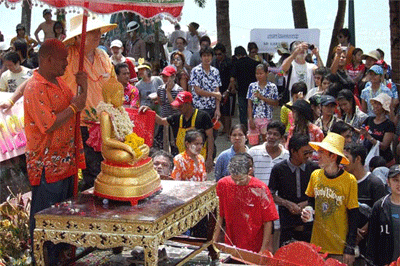
However, there’s a much deeper meaning to Songkran beyond getting drenched. Most Thais in fact head home for its duration, to enjoy a break punctuated by religious ceremonies amongst family. For them it’s a time to express thanks to those they respect, loyalty to ancestors, an awareness of family and social responsibilities and their religious devotion – as well as get wet.
Songkran Customs and Traditions
A period of transition, it’s also a time for new beginnings. Songkran, derived from Sanskrit, means ‘a move over’ or ‘change’, marking the time when the sun leaves Pisces and shifts into the Aries zodiac for the beginning of a new solar year.
To mark this ‘Pi Mai’ (New Year) and get it off to an auspicious start, Thais clean. Everything from Buddha statues in streets to temples and houses gets a renewing wash; meanwhile anything old or unused is thrown out (believed to bring bad luck). They perform bathing rites for monks, and engage in pious activities like giving alms, Dhamma practice and listening to sermons to rinse the spirit clean, to wash away the previous year’s bad actions. They sprinkle water on parents and elders, and shower them with gifts. Thais believe that bad luck or evil is washed away by water, the person purified, and the pouring of a small amount of holy water on another person’s hand or shoulder, confers respect and goodwill. Elders in return wish the youngsters good luck and prosperity.
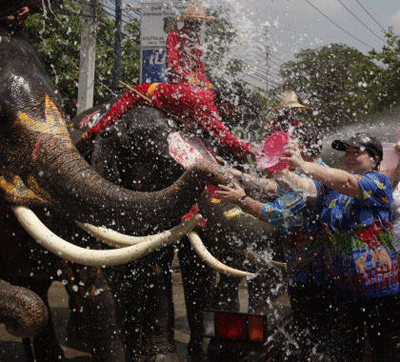
Sanam Luang
Sacred celebrations are held at Sanam Luang, opposite the Grand Palace. Here on the first day of Songkran the Buddha image ‘Buddhasihing’ is brought out from the National Museum and escorted along the streets for people to sprinkle water on.
The image is then located there for three days, so people who missed the procession can pay their respects. Other merit-making customs in Bangkok include the building of sand stupas which are then decorated with colourful flags and flowers. These can be seen around key temples in the Rattanokosin area.
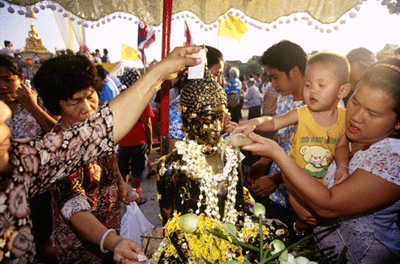
Making Merit
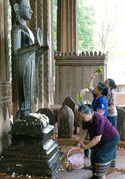
Making merit is an essential part of Songkran, and visiting nine sacred temples during Songkran considered one of the ultimate accumulators. Try temples in the Rattanokosin area like Wat Pho, Wat Phra Kaeo, Wat Suthat Thepphawararam, Wat Chana Songkhram, Wat Boworn, Wat Benchamabophit, Wat Rakhang Khositaram, Wat Arun and Wat Kanlaya.




